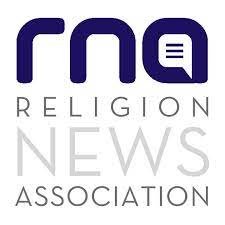Religion beat 'pioneer' Philbrick honored for lifetime achievement
By Debra Mason, RNA executive director
The "regrets" arrived at RNA offices last week in a manner almost unheard of these days: via a letter simply, charmingly typed with the telltale signs of a manual typewriter.
The goldenrod RNA letterhead listing the RNA officers in blood red ink included the name of the letter writer. But the officers were those of 1958-59 and the writer is now 83-years-old.
Richard Philbrick, or "Dick" as he prefers, still keeps in his Maryland home bits of the official RNA letterhead the association used when he became RNA's 6th president (from 1960-62). It is a tender reminder to the lasting role RNA plays in some journalist's lives and in turn, the significance of their contributions to RNA.
Last month the RNA Board unanimously named Philbrick - a former RNA president and groundbreaking Chicago Tribune religion reporter for two decades - the winner of RNA's 2003 Lifetime Achievement Award.
"Please tell my fellow RNA members on my behalf that I deeply appreciate this honor they have bestowed on me. I regard it as a splendid finishing touch to my many pleasant memories of covering the religion beat," Philbrick wrote in the July letter explaining that health reasons prevented him from accepting in person the award at the banquet in Seattle.
Those who knew Philbrick when he was on the beat called him a "pioneer" in the field of religion reporting and one of a dozen grand journalists who helped define and bring respect to religion as a hard news beat.
"He was a formative personality in religion reporting," said Richard Ostling, religion reporter at Associated Press. Ostling covered religion for Time Magazine when Philbrick worked at the Chicago Tribune. Ostling said Philbrick was among the handful of giants in the religion reporting field who, thanks to Vatican II, brought religion reporting prominently to newspapers' front pages as hard news in ways it had rarely been before.
"We never had a religion page and I opposed the idea all along. My feeling was that if religion was worth covering it should be dealt with as news and shouldn't be just put off on a separate page," Philbrick said in a telephone interview. "I wanted it dealt with as a type of news...if a story broke on Tuesday I wanted it running on a Tuesday."
Although competitive in getting stories, Philbrick was still always companionable.
"He was competitive as a reporter but pleasant to deal with. Very competent without being personal or edgy about it," Ostling said.
Former RNA President Russell Chandler, retired from The Los Angeles Times, said Philbrick was quiet, pleasant and meticulous-always asking good questions at press conferences.
Philbrick maintained a meticulous appearance as well, noted by the trademark bow tie he wore.
During his years as an active RNA member, Philbrick served many roles and was a frequent contributor to the newsletter.
He was an RNA vice head in the late 1950s and from 1960-62, president. In 1965 he helped plan RNA's annual meeting in Chicago. He also served on the Supple Contest Committee for 10 years, a sacrifice Philbrick said, because the rules made him ineligible to enter the contest for the entire decade. In 1966, Philbrick joined two other former RNA presidents in signing a petition-along with 55 editors of Catholic periodicals-calling on the U.S. Roman Catholic bishops to open their November 1966 annual meeting to the public. (The bishops finally opened their meetings to journalists in the early 1970s.)
And in preparation for RNA's 25th anniversary in 1974, RNA officers chose Philbrick to write RNA's first, brief history.
Philbrick's career as a journalist began in 1947 at Chicago's City News Service after his discharge from the U.S. Merchant Marines, in which he served during WWII. In 1950 he was hired by the Tribune as a neighborhoods reporter.
Philbrick became the religion reporter in 1954, continuing on the beat for 20 years.
Although the Tribune started a religion beat in 1908, Philbrick said he was the paper's first non-clergyman to hold the job. He joined RNA in 1955 and continues as a retired member today.
During his tenure at the Tribune, Philbrick covered several World Council of Churches meetings - the WCC's second meeting in Evanston in 1954 was his first big religion beat story. He traveled to Rome for the elevation of Cardinal Cody and had other assignments in Europe.
One of his favorite stories to report was the 1961 World Council of Churches meeting in New Delhi. The meeting was held in late November and a favorite memory is when the patriarch of the Greek Orthodox Church surprised the U.S. press corps with a turkey dinner on Thanksgiving Day. "It was a delightful affair," he said.
Philbrick left the religion beat in 1974 to cover politics and then, after covering Chicago's first Mayor Daily for two years, Philbrick retired in 1976.
He and his wife of 56 years, Ruth Rowe Philbrick, then moved to the Washington, D.C. area so Mrs. Philbrick could take a job as a curator at the National Gallery of Art, a position she still holds at the age of 81.
"These Lifetime Achievement Awards are reminders that we did not get here by ourselves," said RNA President Sandi Dolbee in announcing the award. "Going before us were some of the best and brightest journalists of earlier eras, men and women who raised the bar on the coverage of religion in newspapers, news services and magazines. Dick Philbrick was one of these journalists."
This is the third time RNA has given the Lifetime Achievement Award. Wilmar Thorkelson, formerly of the Minneapolis Star-Tribune, received the first award in 2001. Last year former longtime Dallas Morning News religion reporter Helen Parmley was honored.
###
